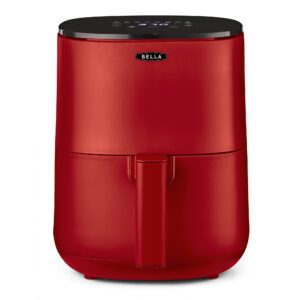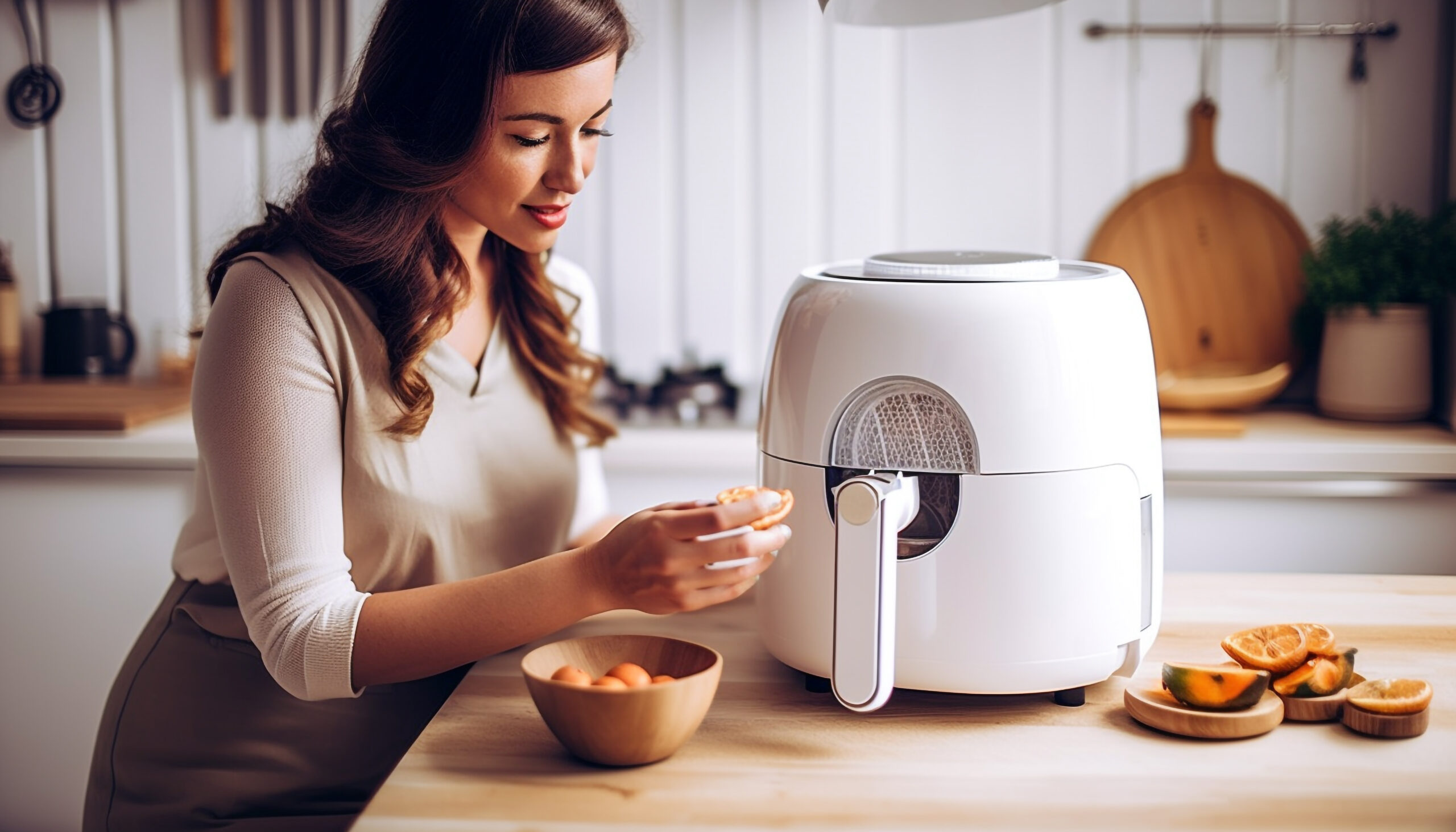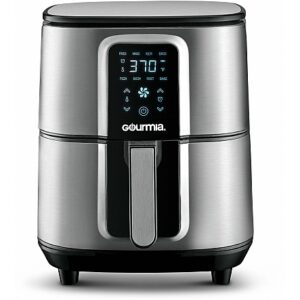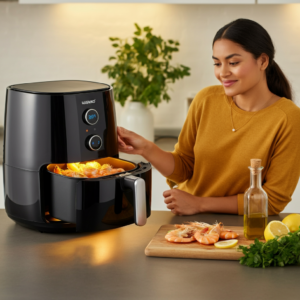Table of Contents
ToggleAir Fryer Directions tips Complete Guide to Use an Air Fryer
Air fryers are no longer just a passing trend. They’ve earned a place in today’s kitchens thanks to their speedy and effective cooking. Millions are sold . This small convection oven has changed home cooking by making fried-style meals using air fryer recipes less oily, quicker, and more convenient.
But like any kitchen tool, success comes down to using the right air fryer instructions. Maybe you just got your first air fryer and feel unsure about preheating it, or you’re trying to perfect golden-crispy fries. This guide dives into it all step by step.
By reading this, you’ll learn:
- Steps to use an air fryer with tips on cooking times
- Deciding if preheating is necessary and the recommended duration
- How to make common foods such as fries, chicken, or fish
- Pro cooking tricks and tools to upgrade your air frying
- Maintenance and cleaning to make your air fryer last
The Basics of Air Fryers – Knowing How They Operate
What Does an Air Fryer Do?
An air fryer is a small kitchen gadget that cooks food by using fast-moving hot air much like a compact convection oven. Instead of dunking food into oil, it relies on a strong fan to push hot air around the food. This makes the food crisp and golden while cutting down fat by 70 to 80 percent according to the Harvard School of Public Health.
Main Parts:
- Heating Element → Provides the heat needed to cook.
- Fan System → Moves the hot air around the ingredients.
- Cooking Basket → Perforated and coated to stop food from sticking.
- Controls → Adjusts temperature and time, either by a screen or old-school knobs.
Air Fryer vs. Oven vs. Deep Fryer
| Feature | Air Fryer | Oven | Deep Fryer |
|---|---|---|---|
| Preheat Time | 3–5 mins | 10–15 mins | N/A |
| Oil Usage | 1 tsp spray | None/optional | You can cook 3–6 cups of food in the best air fryer for optimal results. |
| Texture | Crispy, light results are achievable with the right air fryer recipes. | Evenly baked, less crisp when you follow air fryer tips. | For extra crunchy results, consider using a new air fryer. |
| Health Impact | 70–80% less fat | Moderate | High calorie |
| Convenience | Compact, fast | Large batches | Messy, hot oil risk |
👉 If you’re still deciding, the Cosori Compact & Large Air Fryer is one of the best-rated models for both beginners and advanced cooks.
Step-by-Step Air Fryer Directions
1. Setting Up Your Air Fryer for the First Time
-
Unbox & Inspect – Remove packaging and check for defects.
-
Wash Parts – Basket, crisper plate, and tray should be cleaned with mild soap before use.
-
Test Run – Preheat empty at 400°F for 10 minutes (removes any manufacturing residue).
💡 Pro Tip: Place your air fryer on a flat, heat-resistant surface with 5–6 inches clearance at the back for ventilation, ensuring optimal air fryer cooking.
2. How to Preheat an Air Fryer (and Do You Need To?)
Preheating is one of the most debated topics in air fryer usage, with some users swearing by it for optimal cook time.
When to Preheat:
-
Frozen foods (fries, nuggets, pizza rolls) → crispier results.
-
Meats (chicken wings, pork chops, salmon) → even browning.
When Not to Preheat: Consult a tutorial for the best practices in air frying.
-
Baking (muffins, cookies) → avoids burning bottoms.
-
Delicate veggies (zucchini, broccoli) → prevents overcooking when using the air fry basket.
How Long to Preheat?
-
Small basket models: 3 minutes
-
Larger family-size air fryers: 5 minutes
3. Basic Operating Instructions
-
Plug in & set temperature according to your recipe, ensuring you follow the air fryer recipes for best results.
-
Load basket—never fill more than ¾ full.
-
Use a light oil spray Use avocado or olive oil with a high smoke point for cooking with an air fryer.
-
Shake or flip halfway through for even cooking.
-
Check doneness early—air fryers are faster than ovens.
4. Cooking Popular Foods in the Air Fryer
| Food | Temperature | Time | Tips |
|---|---|---|---|
| French Fries | 400°F | 12–15 min | Shake basket every 5 min |
| Chicken Wings | Alternatively, 375°F is also a great option for the best air fryer results. | 20–25 min | Light oil spray, flip halfway |
| Salmon Fillets | 370°F | 10–12 min | Use parchment liner for easy cleanup |
| Pork Chops | Set your air fryer to 380°F for perfect cooking with an air fryer. | 12–15 min | Try crispy pork chop recipe |
| Brussels Sprouts | 390°F | 8–10 min | Toss with olive oil + seasoning |
| Frozen Pizza Rolls | 390°F | 6–8 min | Preheat for best crispness |
👉 Pro chefs often recommend investing in accessories: skewers, baking pans, and silicone mats to expand what you can cook.
Expert Tips for Best Results
Best Way to Use an Air Fryer
-
Don’t overcrowd the basket → prevents soggy food.
-
Use oil sparingly → just a mist is enough.
-
Cook in batches for even results in the air fryer basket. → better crisp, less steam.
-
Adapt oven recipes → reduce temperature by 25°F and time by 20%.
Can You Put Parchment Paper in an Air Fryer?
Yes—Using perforated parchment liners can enhance your cooking with an air fryer. are safe. Regular parchment can block airflow and even catch fire.
Troubleshooting Common Issues
-
Food isn’t crispy: Basket too full or not enough oil spray.
-
White smoke: Excess grease or oil dripping. Clean tray and use drip liner.
-
Burning smell: Residue on heating coil—clean thoroughly.

Cleaning and Maintenance
How to Clean an Air Fryer After Use
-
Unplug & cool down.
-
Wash basket & tray with warm soapy water or dishwasher-safe cycle.
-
Wipe heating coil & interior with damp cloth.
-
Remove odors while cooking with an air fryer by using the right time and temperature. by running lemon slices or vinegar water for 2 minutes.
Extending the Life of Your Air Fryer
-
Avoid shaking the basket too vigorously during cooking. metal utensils (scratches non-stick).
-
Use silicone or wooden tools.
-
Clean after every use to prevent grease buildup.
-
Store in a dry, ventilated space.
Advanced Air Fryer Techniques
Cooking with Accessories
-
Silicone Baking Cups → muffins, eggs, desserts.
-
Rotisserie Attachments → whole chicken or kebabs.
-
Grill Pans → sear steaks and burgers.
Recipe Conversion Formula
If converting from oven to air fryer:
-
Reduce temp by 25°F
-
Reduce time by 20%
Using Foil and Liners Safely
-
Foil is safe if it doesn’t block air vents in the air fryer basket.
-
Silicone mats These are reusable and eco-friendly, making them perfect for your new air fryer.
Nutrition & Health Benefits of Air Frying
-
Calorie Savings: Learn how to cook in an air fryer for healthier meals. Studies show air frying can cut fat intake by 70–80% compared to deep frying (source: Harvard Health).
-
Reduced Acrylamide: Air frying can reduce formation of harmful compounds compared to deep frying (source: FDA).
-
Portion Control: Smaller basket sizes encourage mindful cooking.
Air Fryer FAQs
Q1: Do all air fryers need preheating?
Not all air fryers need preheating. Smaller basket models heat up quickly and can cook food without it, but larger digital air fryers benefit from a 3–5 minute preheat for consistent crispiness. As a rule, preheat when cooking frozen foods, meats, or fries, but skip it for delicate baking recipes like muffins or cakes.
Q2: Can I put aluminum foil in an air fryer?
Yes, you can put aluminum foil in an air fryer, but it should never cover the entire basket. Air fryers work by circulating hot air, and blocking airflow reduces crispiness and increases cooking time. For safety, use foil only to line the bottom or wrap food—never cover vents or heating elements.
Q3: Why does food sometimes come out soggy in an air fryer?
Food comes out soggy in an air fryer when the basket is overcrowded or ingredients contain too much moisture. To fix this, pat foods dry before cooking, use a light oil spray for crispness, and cook in smaller batches. Proper air circulation is essential for achieving golden, crunchy results.
Q4: Can I bake cakes in an air fryer?
Yes, you can bake cakes in an air fryer. Many models include cake pans or silicone molds as accessories, making them versatile for desserts. When converting oven recipes, lower the temperature by 25°F and reduce cooking time by about 20% to prevent overbaking. This works for cupcakes, brownies, and muffins too.
Q5: What’s the difference between a manual and digital air fryer?
The difference between manual and digital air fryers is in controls and precision. Manual models use dials for time and temperature, while digital versions offer presets, LED displays, and greater accuracy. Digital air fryers are ideal for beginners who want step-by-step guidance, while manual units appeal to users who prefer simplicity.
Q6: Are air fryers safe to use?
Yes, air fryers are safe when used correctly and according to the manufacturer’s manual. Always keep the appliance on a flat, heat-resistant surface, allow airflow clearance, and avoid covering vents. For long-term safety, clean the heating coil and basket regularly to prevent grease buildup that could cause smoke or odors.
Conclusion – Mastering Your Air Fryer
Following the right air fryer directions transforms your cooking: crispier fries, juicier meats, and healthier meals in less time. From setup and preheating to cleaning and advanced hacks, this guide gives you everything you need to cook like a pro.
👉 Ready to upgrade your kitchen? Check out the Cosori Air Fryer or try our crispy air fryer pork chops recipe to put these tips into practice.
Master the method, and you’ll never look at traditional frying the same way again.


